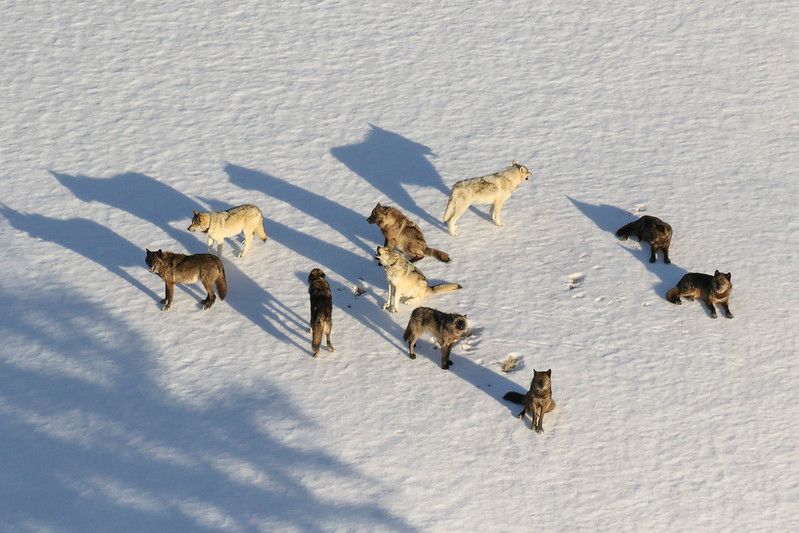Yellowstone wolf pups car accident - flight zone recon
Canis lupus in its natural habitat is an exemplary wild predator. Living in family packs it hunts (food finding), stays safe (active protection or passive risk avoidance) and reproduces. To sum up - it survives, where one of conditions to be fulfilled is avoiding a human.

Last year's December, I found two interesting news during few days of browsing North American websites. One of them encouraged to observe wild Yellowstone wolf packs' members as easy to notice on the fresh snow during consumption of hunted animal carcasses, in company of scavenging birds and competitive mesopredatory carnivores looking for their chance (it pointed on some data coming from current official Yellowstone reports).[1] Whereas another one informed about a pair of Yellowstone National Park's wolf pups (confirmed as Junction Butte pack leading pair's offspring) fatal hit by a vehicle when they hung around a road - their den was localized nearby, likely caused by them getting used to human activity (sounds and smell of moving objects for example).[2]
In the NPS Yellowstone status it stands clear:[3]
Never feed wildlife. Animals that become dependent on human food may become aggressive toward people and have to be killed. Keep all food, garbage, or other smelly items packed away when not in use.
and
Never approach animals. The animals in Yellowstone are wild and unpredictable, no matter how calm they appear to be. The safest (and often best) view of wildlife is from inside a car. Always stay at least 100 yards (91 m) away from bears and wolves, and at least 25 yards (23 m) away from all other animals, including bison and elk.
And yet, according to recent Yellowstone Park press release, the "stay 100 yards away" rule was being repeatedly violated.
During the summer of 2019, the pack of 11 adults attended a den of pups near a popular hiking trail in the northeastern section of the park. Wanting to keep visitors and wolves apart, the park closed the den and surrounding area to the public. When the pups approached the trail and were in proximity to hikers, most people quickly moved away. However, some people violated the required 100-yard distance from wolves and approached the pups when they were on or near the trail to take a photo. Other people illegally entered the closed area to get near the wolves. Having grown accustomed to hikers, the pups then came close to visitors along a road.
— reported details[4] suggest a human recurring appearance in the middle of those pups' developmental management's crucial stage, which includes a very short part of being socialisation-habituation extremely predisposed.
It made me think about Yellowstone wolves again. If they have shortened their flight zone - by adaptation to common visitors, scientists and wildlife observers, entire tourism in general - treating the offered environment like an ecological niche. Trimmed in such a way flight zone recalls taming as a defined process (in the context of each singular wolf), reduced reactivity if other species exists close by (including social behavior selective modification) and finally, adaptation to human presence itself (half-tamed animals - accidentally or in specific conditions allowing particular individuals to survive; and hand-reared - by skilled trainers / behaviorists / researchers / scientists or by not skilled, adventitious wolf-keepers).
Wildlife, as a set of multiplicitous ecosystems, defines all of plants (flora) and most of animals (fauna) living there without human influence or just not affected by human activity (otherwise, a wild animal is avoiding a human even when remaining in its natural habitat). Wild animals are not restrained by their natural environment, not tamed nor domesticated. Every species existence proceeds in keeping with its nature and instinct. Canis lupus in its natural habitat is an exemplary wild predator. Living in family packs it
- hunts (food finding prioritised)
- stays safe (active protection (intraspecific competition) or passive risk avoidance (interspecific competition))
- reproduces (an offspring as a main goal).
To sum up - it survives, where one of the conditions to be fulfilled is avoiding a human. If an animal is able to not be scared of human presence in a relatively close distance, it means that taming is possible. A tamed animal is a wild animal which previously adapted to humans in a natural way (socialization/habituation process) or by human intervention (animal training).
What's positive
- an animal is easy to observe, still living in its relatively natural habitat
- scientists, researchers and wolf lovers benefit for science, study and wolf advocacy - more knowledge, collected data, educated ranchers, farmers, citizens, social media sympathy.
And negative
- observer effect (Hawthorne effect) associated changes caused by awareness of being observed (optionally modified behavior), then adaptation to the situation (feeling safe consequence)
- unstable / unpredictable reactions and behaviors deviating from ethogram[5] like scavenging on garbage instead of hunting destined preyed animals (resources reachable within ecological niche) or approaching too close to potentially dangerous objects (limited avoidance).
Recently reviewed book written by Elly Radinger was equipped with hand-held guide - in case of a scheduled trip to wolf inhabited regions accessible to visitors (vide Yellowstone National Park, USA) - and with instructions on how to behave in case a wolf meeting in wildlife (aimed at Germany).
Wild wolves' situation within the European area is generally different from their distant fellows. American wolves (Arctic, Timber and so on) are indeed easy to observe in wildlife - they live mostly in vast treeless territories, migrating between hunters trophy zones where to shoot them is allowed almost in every state. Wolves in Europe (Eurasian type) are difficult to encounter in wildlife - they migrate across the continent strictly protected by EU in the membership countries, hunting their destined prey in almost every forest.
Polish Association for Nature "WOLF" issued official rules dedicated to local residents, forest workers (forest rangers, foresters, lumberjacks), professionals (scientists, researchers, wolf watchers, wildlife photographers), common tourists and mushroom pickers - it precisely describes point by point how to act properly. It emphasises: to not feed wild animals intentionally,[6] to keep garbage secured, to not leave food in camp places (even if they look cleaned up regularly), to take lunch leftovers away from forest workplaces and not set up temporary trashcans. The goal of it is to prevent the creation of the one of fundamental survival conditions indispensable for ecological niche to be adapted - a food resource reachability without a hazard.
If you are a wildlife photographer or a hunter, never provide meat to bait animals near hideouts, observation towers or balconies. Wolves, thanks to sensitive scent sense, can start to perceive humans as food management.
That rule concerns especially wolf youngsters (socialization/habituation aspect).
Polish road reports inform about approximately 50 wolves - among them some pups - confirmed fatally hit by car in 2019, above all in sections overlapping forest or field-forest areas.[7] European road accidents' involving wild animals situation are strictly related to unlimited animal migration - by wildlife corridors (far from human activity, hazard avoidance) or just across random roads if such corridor is not available (danger ignored by frightened or determined animals).
Ecotourism and proper education are essential.
- Correctly interpreted ecotourism means usage of knowledge in practise like animal footprints to identify, ecosystem study or data to collect, trekking and hiking trips. It also means the ethical photography and wild animals observation from rigorous distance and in complete silence. If it progresses, ecotourism would correlate to profits (cabins rental, local souvenirs trade, guides payment).
- Correctly educated person balances teaching and learning implications - wildlife-human conflict decreases, wolf awareness increases. If it progresses, education is able to be passed in theory down to others (vide conversations, seminars), performed (vide presentations, workshops) and practised by ecotourists.
Both of them should always collaborate with each other.
[1] NBC [Wyoming US, 16th Dec.2019]
[2] OIL CITY NEWS [Montana US, 18th Dec.2019]
[3] Yellowstone National Park regulations about wolves
[4] NPS official release
[5] Scientific description of a structure and its important components which are typical for selected species behavioral model, including instinctive reactions, rigid patterns and elastic habits, to make its representatives part of an established standard.
[6] Feeders functionality should be reconsidered paying attention to terms of their necessity - scientifically and expertly justified.
[7] Association for Nature "WOLF" [Poland, 31th Dec.2019]

